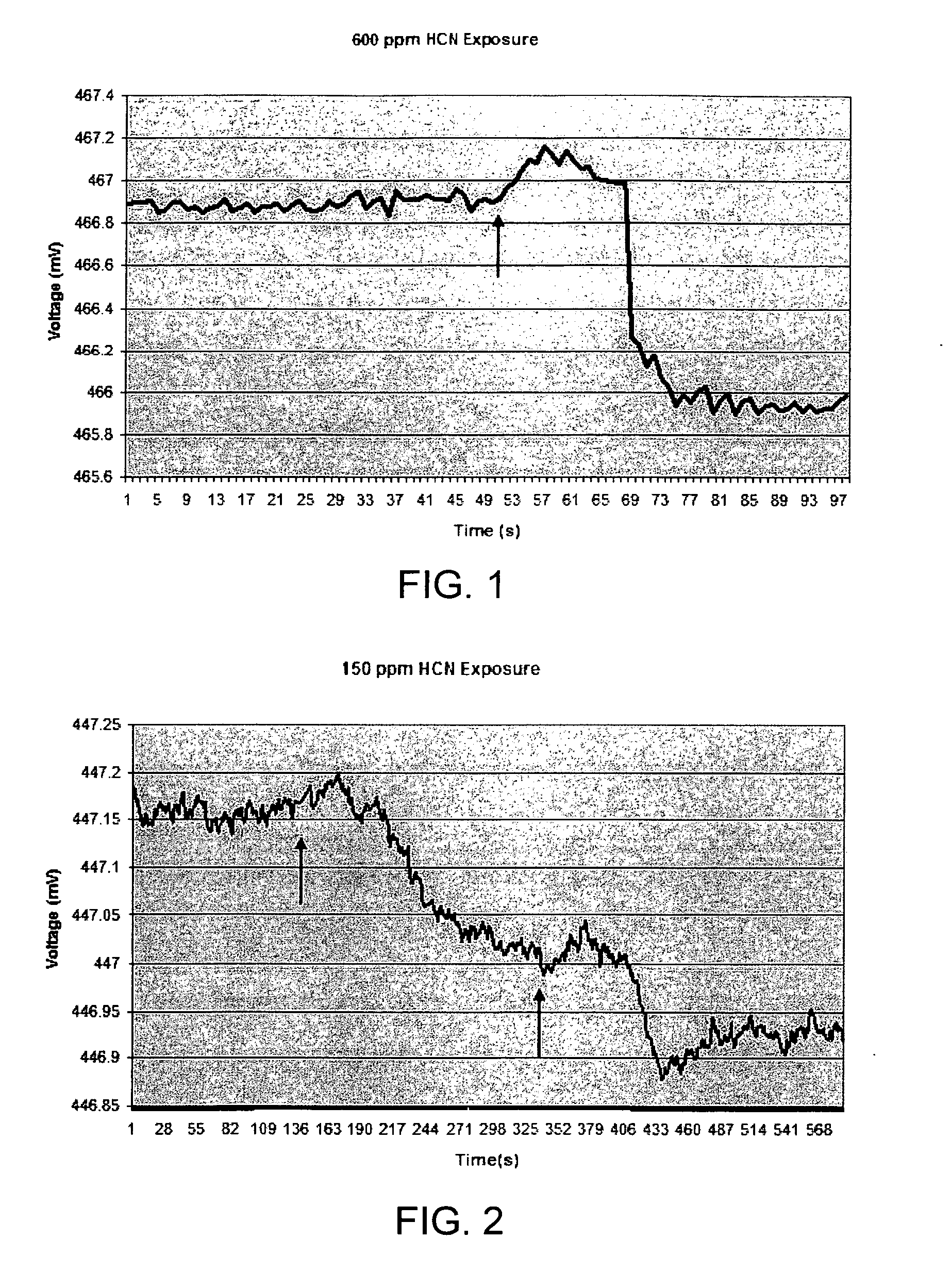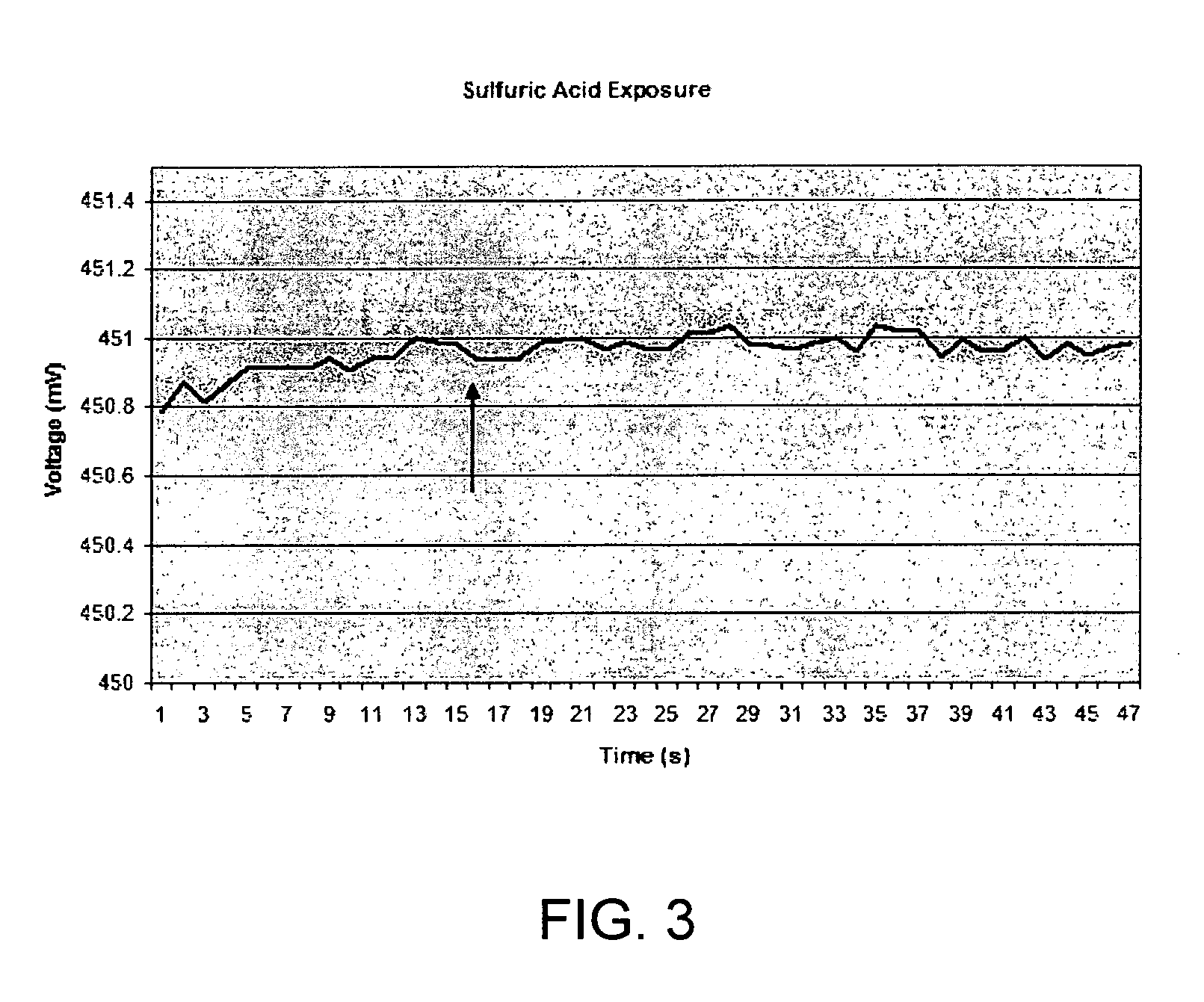Microsensor material and methods for analyte detection
a microsensor and analyte technology, applied in the field of chemical or biological analytes detection, can solve the problems of difficult to obtain sensors, reduce performance and eventual failure, and not ideally suited to all applications, and achieve the effects of increasing the free volume of polymeric materials, and free volum
- Summary
- Abstract
- Description
- Claims
- Application Information
AI Technical Summary
Benefits of technology
Problems solved by technology
Method used
Image
Examples
example 1
Sensor Material to Detect Hydrogen Cyanide
[0091]An exemplary sensing material was comprised of a kertain matrix in combination with thiolated colloidal gold particles. a-keratins assemble intermediate filaments by forming multiple disulfide cross-links among the molecules (Nelson and Cox (2005) Principles of biochemistry, W. H. Freeman and Co.). Alkanethiol monolayers form on gold surfaces by strong coordination of alkanethiol compounds to gold by self-assembly (Bain (1989) J. Am. Chem. Soc. 111:321-335; Nuzzo and Allara (1983) J. Am. Chem. Soc. 105:4481-4483; Whitesides and Laibinis (1990) Langmuir 6:87-96).
[0092]Keratin was mixed first with 2-mercaptoethanol to reduce disulfides to sulfhydryls, and then with colloidal gold to form a self-assembled matrix of nanogold-keratin via gold thiolate coordination. The source of keratin was VariKer 100 keratin powder (Variati and Company, Milan, Italy). Colloidal gold source was particles with a diameter of 20 nm in aqueous suspension (Sigm...
example 2
Exposure of the Sensor Material to Different Concentrations of HCN
[0098]Sensor material as described in Example 1 was also exposed to lower levels of HCN and the increase in polymer volume was detected using an EPM sensor. FIG. 2 shows the initial response of the sensor material to an exposure of approximately 150 ppm HCN. H2SO4 was added to KCN to evolve HCN at 139 second, as indicated by the arrow. As with the experiments described in Example 1, the initial sensor response was an increase in voltage, indicating that the microcantilever moved toward (into) the sensor material. The initial increase in sensor voltage was followed by a decrease in voltage, as before. The overall time frame for the response to the 150 ppm exposure was about 210 second, or approximately 5 times the length on the response time for 600 ppm HCN. The net voltage change from initial reading to final reading was approximately 0.15 mV, or ⅙ of the previous 600 ppm voltage response. The estimated net cantilever...
example 3
Negative Controls
[0100]Several negative control experiments were performed to confirm that the analyte sensor operated as predicted. The negative control experiments were performed in the absence of analyte, polymer matrix, or particles. The results of the experiments indicated that the analyte sensor requires both a polymer matrix components and solid particle component to respond to an analyte in the manner described. The polymer matrix or solid particle, alone without the other component, is ineffective as an analyte sensor, supporting the theory of operation.
[0101]1. No Analyte (H2SO4 Vapor Only)
[0102]Similar sensor material to that used in Examples 2 and 3 was exposed to H2SO4 vapors only, in the absence of a KCN analyte. Here, the sensor was present in the chamber when sulfuric acid was injected in through a rubber membrane with a syringe. The amount of acid vapor was similar to that present in the 600 ppm-experiment of Example 1. The results are shown in FIG. 3, with the arro...
PUM
| Property | Measurement | Unit |
|---|---|---|
| diameter | aaaaa | aaaaa |
| diameter | aaaaa | aaaaa |
| diameter | aaaaa | aaaaa |
Abstract
Description
Claims
Application Information
 Login to View More
Login to View More - R&D
- Intellectual Property
- Life Sciences
- Materials
- Tech Scout
- Unparalleled Data Quality
- Higher Quality Content
- 60% Fewer Hallucinations
Browse by: Latest US Patents, China's latest patents, Technical Efficacy Thesaurus, Application Domain, Technology Topic, Popular Technical Reports.
© 2025 PatSnap. All rights reserved.Legal|Privacy policy|Modern Slavery Act Transparency Statement|Sitemap|About US| Contact US: help@patsnap.com


